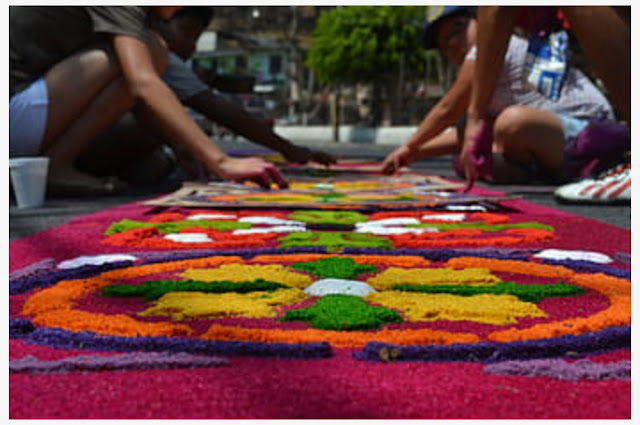About the
colorful festival – Holi
 |
| Holi the festival of colors |
Holi is a popular festival to
all age people in India. It is a traditional Hindu festival which means festival
of colors. It is the festival of color and love, as well as the triumph of good
over evil. It is meant for the end of winter and the beginning of spring and
takes place over two days. It is a festival of spring which always falls on Purnima, or the day of the full moon.
Holi has been celebrated in
the Indian subcontinent for centuries and it is still widely celebrated as a
religious festival. It is celebrated in many places around the world.
Holi goes on for a night and a
day, beginning on the night of the Purnima
falling in the month of Phalguna, which
falls somewhere close to the finish of the month February and the center of
March. The primary night is also known as Holika
Dahan or Chhoti Holi and the
next day is popular as Holi or Rangwali Holi.
HOLIKA DAHAN
Holika Dahan is
celebrated by burning Holika, an
evil. For many traditional stories of Hinduism it is called as Prahlad a devotee of God Vishnu was trying to kill by Holika, and it is the order of his own
father Hiranyakashipu, as he is the
king of the asuras and he did not want to have a son like Prahlad. Father ordered his son Prahlad to get
rid of worshipping of Vishnu and worshipped him as a God; but when Prahlad
disagreed with his father, and refused to worship his father as a god. Then Holika
(Hiranyakashipu’s sister and Prahlad’s aunt) and Hiranyakashipu were trying to kill him but God Vishnu rescued
his devotee Prahlad and burnt the devil Holika. So, Holi gets its name. Thus, still
the people celebrate Holika Dahan by burning wood and dung-cakes in a symbolic
pyre to signify good defeating evil.
RANGWALI HOLI
The next day of Holika Dahan is celebrated as Rangwali Holi. Throwing of power or liquid colors on each other is the hallmark of Rangwali Holi. It refers as ‘Holiday of Colors’.
 |
| Playful Holi image |
Traditional Colors of Holi
Traditionally, Holi colors
were made from natural sources. It is believed that during the spring season
the weather changes and causes viral fever and cold. The playful throwing of
natural colored powers, called gulal
has a medicinal significance. The colors were traditionally made of neem,
kumkum, haldi, flowers, fruits and herbs.
Many colors are obtained by mixing two or three primary colors.
Orange and Red:
Red symbolizes love and
fertility and orange symbolizes health and vitality. Red and orange colors are occurred
by the flowers of palash or tesu tree. Also many other sources are
hibiscus flower, red sandalwood, madder tree, radish, turnip and pomegranate. Mixing
lime with turmeric power one gets the lovely color of orange.
Green:
Green refers nature and new
beginnings. Green color mainly occurred by mehendi
and dried leaves of gulmohur tree. People
also use several herbs (neem, tulsi) as an alternate source of green.
Yellow:
Yellow signifies as a natural remedy.
It is because the main source of yellow color is Haldi (turmeric) power which is a good natural medicine. Bael fruit,
amaltas, species of marigold are alternate sources of yellow color.
Blue:
Blue represents the Hindu Lord
Krishna. The traditional sources of blue color are Indigo plant, Indian berries,
grapes, blue hibiscus and jacaranda flower.
Purple:
Purple represents magic and
mystery. Beetroot is the traditional source of purple color.
Brown:
Brown refers to Earth and it
relates to protection, security and material wealth. Dried tea leaves and clays
are best alternate source of brown.
Black:
Black represents the Lord
Krishna, the manifestation of Vishnu as his name means ‘dark’. Species of
grapes, fruits of amla or gooseberry and vegetable carbon or charcoal offer
gray to black colors.
In ancient times people used natural
colors to play Holi as they believed that it is a festival of human beings and
nature. Lord Krishna played Holi with his beloved Radha and friends, and that’s
why they use the natural rangs to color each other as Lord Krishna also used
the natural colors to play holi.
 |
| Rangoli image |
Synthetic colors and its
impacts
As time passes, people have
been more civilized and the population rate also increases every year. So, in
the Holi festival people make synthetic colors as all the natural resources are
not available to all. So, the synthetic colors take the place of natural
colors.
The natural colors had positive effects on
human body and even on animals also. The natural colors can also strengthen the
ions in the body to promote good health and beauty.
But several synthetic colors
cause skin irritation and inflammation. Lack of control over the quality and
content of these colors is a problem as they are frequently sold by vendors who
do not have the knowledge of their sources.
 |
| Don't throw color on the innocent animals; the colors may take their life |
Even some people throw colors on dogs and
other animals. It causes a very harmful effect on the animal’s body as they do
not take a proper bath to remove the chemical coloring. Various skin disease
take place on their body and slowly it kills the innocent animals. Sometimes,
these innocents lick the chemical colors in order to remove it from their body.
Comments
Post a Comment